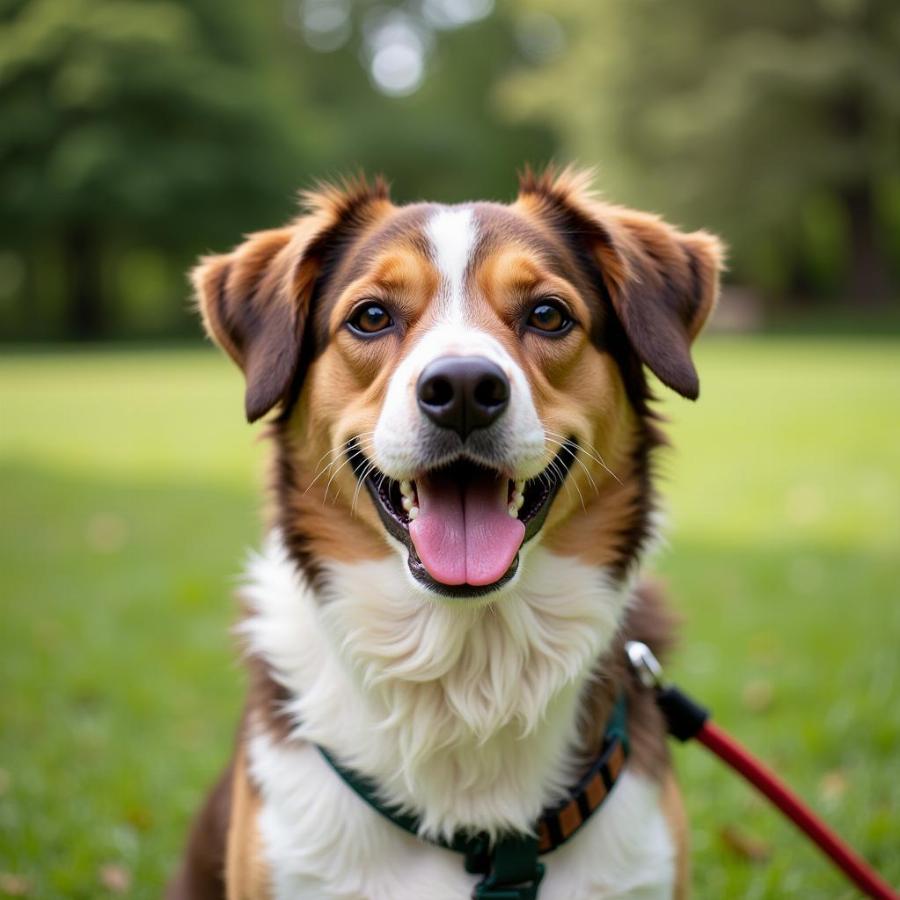A tie out for dogs can provide a safe and convenient way for your furry friend to enjoy the outdoors. However, using a tie out improperly can lead to behavioral problems, injuries, and even tragedy. This comprehensive guide will explore everything you need to know about tie outs for dogs, from choosing the right type to ensuring your dog’s safety and well-being.  Chó cảnh sử dụng dây buộc ngoài trời
Chó cảnh sử dụng dây buộc ngoài trời
Understanding Dog Tie Outs: What Are They and Why Use Them?
Dog tie outs are essentially long leads or cables that allow dogs to roam within a defined area while remaining tethered to a fixed point. They can be useful in various situations, such as camping, picnics, or simply providing your dog with some outdoor time in a yard without a fence. Tie outs offer a degree of freedom while preventing your dog from wandering off or getting into trouble. Are tie outs a good idea for every dog? Certainly not, and we’ll delve into that later. Choosing the right tie-out is paramount to your dog’s safety.
Choosing the Right Tie Out for Your Dog
Selecting the appropriate tie out depends on various factors, including your dog’s size, temperament, and the environment. A tie out for dogs comes in various materials, lengths, and styles. Here’s a breakdown of common types:
- Cable Tie Outs: These are typically made of strong, coated steel cables and are suitable for most dogs. They’re durable and resistant to chewing. For larger, stronger breeds, consider a cable tie out for dogs with a thicker cable.
- Rope Tie Outs: Rope tie outs can be a lighter option for smaller dogs, but they are more susceptible to chewing and weather damage. Supervise your dog closely when using a rope tie out.
- Trolley Systems: Trolley systems allow your dog to move along a cable strung between two points, offering more freedom of movement than a stationary tie out. This can be an excellent option for dogs who enjoy exploring their surroundings.
Safety First: Using Tie Outs Responsibly
While tie outs can be beneficial, they also pose potential risks if not used correctly. Never leave a dog tied out unsupervised for extended periods. Loneliness, boredom, and frustration can lead to behavioral issues, and a tied-out dog is more vulnerable to attacks from other animals.
What are some safety tips when using a tie out for dogs?
- Proper Supervision: Always supervise your dog while they are tied out. This allows you to intervene if any problems arise.
- Appropriate Length: The tie out should be long enough to allow your dog to move around comfortably but not so long that they can reach hazards like roads or other animals’ territories.
- Secure Anchor Point: The tie out must be securely anchored to a sturdy object that won’t move or break.
- Safe Collar or Harness: Use a well-fitting collar or harness specifically designed for tie outs. Avoid choke chains or prong collars, as these can cause injury.
- Weather Considerations: Be mindful of the weather. Don’t leave your dog tied out in extreme heat or cold. Provide shade and water.
- Check for Hazards: Regularly inspect the tie out area for potential hazards like sharp objects, poisonous plants, or holes.
- Rotate Tie-Out Locations: Change the tie-out location periodically to prevent excessive wear and tear on the ground and to provide your dog with some variety.
Behavioral Considerations: Is a Tie Out Right for Your Dog?
Not all dogs are suited for tie outs. Are westies hypoallergenic dogs? While that’s a different topic, it illustrates that each breed has unique needs. Similarly, some dogs become anxious or territorial when tied out. Observe your dog’s behavior closely. If they exhibit signs of stress or aggression, a tie out may not be the best option.
Conclusion: Tie Outs for Dogs – A Useful Tool with Important Considerations
Tie outs can be a valuable tool for dog owners, providing a safe and convenient way for their furry companions to enjoy the outdoors. However, responsible usage is crucial. By choosing the right tie out, prioritizing safety, and understanding your dog’s individual needs, you can ensure a positive experience for both you and your pet. Remember to always supervise your dog while tied out and never leave them unattended for extended periods. The tie-out meaning dog safety and well-being should always come first.
FAQ:
- Can I use a tie out for my puppy? Generally, it’s best to avoid using tie outs for puppies, as they are more prone to chewing and entanglement.
- What is the best material for a tie out? Coated steel cables are generally the most durable and resistant to chewing.
- How long can I leave my dog tied out? Never leave your dog tied out unsupervised for extended periods. Short, supervised outings are best.
- What should I do if my dog becomes entangled in the tie out? Remain calm and carefully untangle your dog. Check for injuries afterward.
- Are there any alternatives to tie outs? Consider a fenced yard, long leash walks, or supervised playtime in a safe open area.
Want to Learn More? Check Out These Related Articles:
Beaut Dogs is your trusted source for all things related to dog care. We’re passionate about providing expert advice and helpful information to help you navigate the joys and challenges of dog ownership. When you need support, please contact Email: [email protected] to have Beaut Dogs answer in detail and accurately. Visit us at https://beautdogs.com to learn more.